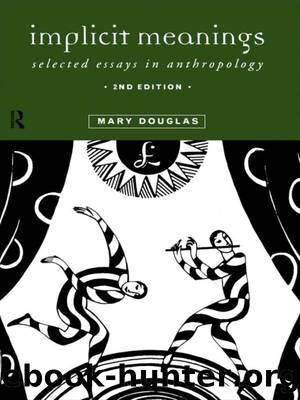Implicit Meanings by Douglas Mary

Author:Douglas, Mary.
Language: eng
Format: epub
Tags: ebook
Publisher: Taylor & Francis (CAM)
Published: 2011-10-15T16:00:00+00:00
SOCIAL CONTROL OF PERCEPTION
While hailing this joke pattern as authentic, it is a very different matter to use it for identifying jokes. First we should distinguish standardised jokes, which are set in a conventional context, from spontaneous jokes. Freudâs claim to have found the same joke pattern in all joking situations hides an important shift in levels of analysis. The standard joke, starting for instance with âHave you heard this one?â or âThere were three men, an Irishman, etc.â, contains the whole joke pattern within its verbal form. So does the pun. The joke pattern can easily be identified within the verbal form of standard jokes and puns. But the spontaneous joke organises the total situation in its joke pattern. Thus we get into difficulties in trying to recognise the essence of a spontaneous joke if we only have the utterance or the gesture and not the full pattern of relationships. If the Kaguru think it witty to throw excrement at certain cousins or the Lodagaba to dance grotesquely at funerals or the Dogon to refer to the parentsâ sexual organs when they meet a friend, then to recognise the joke that sends all present into huge enjoyment we need not retreat into cultural relativism and give up a claim to interpret. The problem has merely shifted to the relation between joking and the social structure.
The social dimension enters at all levels into the perception of a joke. Even its typical patterning depends on a social valuation of the elements. A twentieth-century audience finds the Marivaux comedy weak because it one-sidely presents the aristocratsâ manners as live and their servantsâ manners as lifeless imitations. But to an eighteenth-century audience of French aristocrats any dramatist presenting both lords and commoners as equally lively in thier own right would have had, not a comedy, but a theme of social reform to tempt only a Bernard Shaw in his most tendentious vein. In every period there is a pile of submerged jokes, unperceived because they are irrelevant or wrongly balanced for the perspective of the day. Here let me try to save the definition of the joke pattern from the charge that it does not include modern forms of humour, such as the shaggy dog story or the sick joke. The shaggy dog is only told in a society which has been satiated with joke stories. The joke of the tale that goes on in a declining spiral to a nadir of pointlessness lies in the dashed expectations of the listeners: the humour is not in the verbal utterances but in the total situation in which it is a practical joke. The sick joke expresses a parallel sophistication in joke forms. It plays with a reversal of the values of social life; the hearer is left uncertain which is the man and which the machine, who is the good and who the bad, or where is the legitimate pattern of control. There is no need to labour the point that such a joke
Download
This site does not store any files on its server. We only index and link to content provided by other sites. Please contact the content providers to delete copyright contents if any and email us, we'll remove relevant links or contents immediately.
The Art of Thinking Clearly by Rolf Dobelli(10149)
Mindhunter: Inside the FBI's Elite Serial Crime Unit by John E. Douglas & Mark Olshaker(9112)
Change Your Questions, Change Your Life by Marilee Adams(7574)
Nudge - Improving Decisions about Health, Wealth, and Happiness by Thaler Sunstein(7469)
Mastermind: How to Think Like Sherlock Holmes by Maria Konnikova(7171)
The Power of Now: A Guide to Spiritual Enlightenment by Eckhart Tolle(5550)
Men In Love by Nancy Friday(5120)
Altered Sensations by David Pantalony(5013)
Factfulness: Ten Reasons We're Wrong About the World – and Why Things Are Better Than You Think by Hans Rosling(4635)
The Confidence Code by Katty Kay(4166)
Thinking in Bets by Annie Duke(4127)
Man and His Symbols by Carl Gustav Jung(4016)
The Worm at the Core by Sheldon Solomon(3401)
Why Buddhism is True by Robert Wright(3378)
Liar's Poker by Michael Lewis(3330)
Three Women by Lisa Taddeo(3327)
The Inner Life of Animals by Peter Wohlleben(3204)
Descartes' Error by Antonio Damasio(3194)
The Power of Mindful Learning by Ellen J. Langer(3137)
